

Move your mouse over the picture to see the names of the various craters.
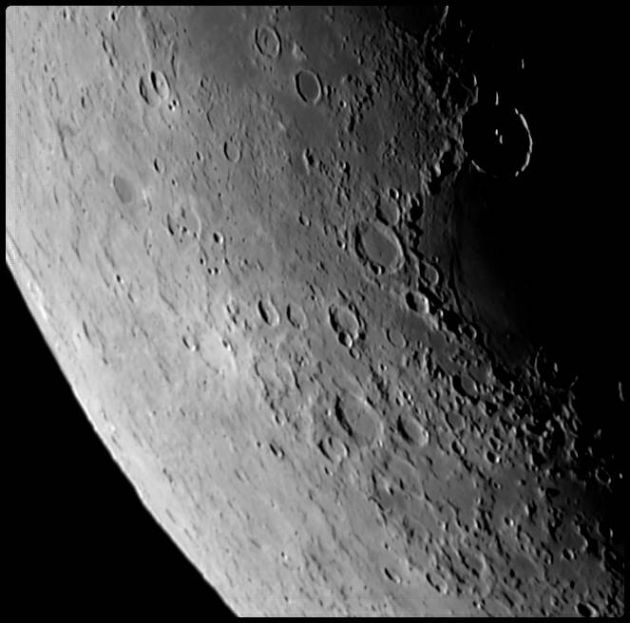
This picture is a composite of two pictures taken on the same night and shows the south-western limb of the Moon.
If you were there on the floor of the crater Gassendi the sun would have set, but you would still be able
to see it striking the top of the central mountain and the mountains in the east.
Below is a closer picture of Gassendi under
morning lighting.
The picture was taken with a ToUcam attached to my ETX125 on 23rd August 2003, when the Moon was 24.9 days old.
Lunar Phase: 236.0°
Colongitude: 218.4°
Date and Time: 23rd August 2003 02:56 UT
Camera: ToUcam 740K
Telescope: ETX125 at prime focus
Capture: K3CCDTools. High gamma, 1/25", 0% gain, 300 frames
Processing: Registax. 163 frames stacked. Wavelet 1-2 = 5
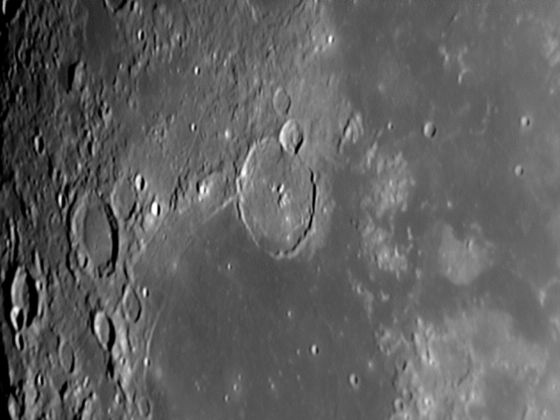
Gassendi is a large crater (114 Km in diameter) situated on the northern shores of the Mare Humorum.
There are several central mountains, the highest being 1200 metres high. Other major craters in the picture
are Mersenius (87 Km in diameter and 2300 metres deep) and Cavendish (58 Km in diameter and 2300 metres deep).
The scale markers are 100 Km north and east.
The picture was taken with a ToUcam attached to my LX200 on 25th October 2004 at 22:42 UT,
when the Moon was 12.6 days old.
Lunar Phase: 26.1°
Colongitude: 58.5°
Date and Time: 25th October 2004 at 22:42 UT
Camera: ToUcam 740K
Telescope: LX200 at prime focus (FL 2500 mm)
Capture: K3CCDTools. High gamma, 1/500", 12% gain, 307 frames
Processing: Registax. 157 frames stacked. Wavelet 1,2 = 10
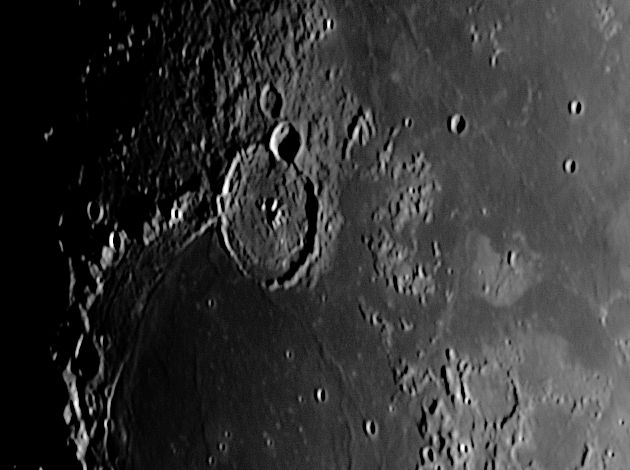
In this picture, taken at a very similar lunation, I have used a sigmoid gamma curve to try to emphasise the rugged nature of the floor of Gassendi. Close-up pictures taken from orbit, indicate that the wall of Gassendi is intact across its southern side suggesting that the crater could not have been flooded with lava from Mare Humorum. The crater is evidently younger than the Humorum basin, so presumably was tilted to the south at formation. This may explain why the mare lavas reach nearly to the top of the ring wall on the outside, but not on the inside. It may well be that lava welled up through cracks in the floor caused by movement of Humorum as it filled with lava, but that doesn't account for its generally rugged appearance. Better pictures than mine show that there are many rills crossing the floor, which accounts for some of the unevenness. My own feeling is that the crater floor is covered with ejecta from elsewhere (maybe the Orientale basin).
The scale markers are 100 Km north and west.
The picture was taken with a ToUcam attached to my LX200 on 12th November 2005 at 22:46 UT,
when the Moon was 11.5 days old.
Lunar Phase: 39.2°
Colongitude: 47.5°
Date and Time: 12th November 2005 22:46 UT
Camera: ToUcam 740K
Telescope: LX200 at prime focus (FL 2500 mm)
Capture: K3CCDTools. Low gamma, 1/33", 9% gain, 452 frames
Processing: Registax. 103 frames stacked. Wavelets 1 = 10, 2 = 5, gamma sigmoid
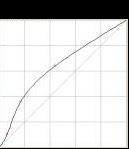 The gamma curve.
The gamma curve.
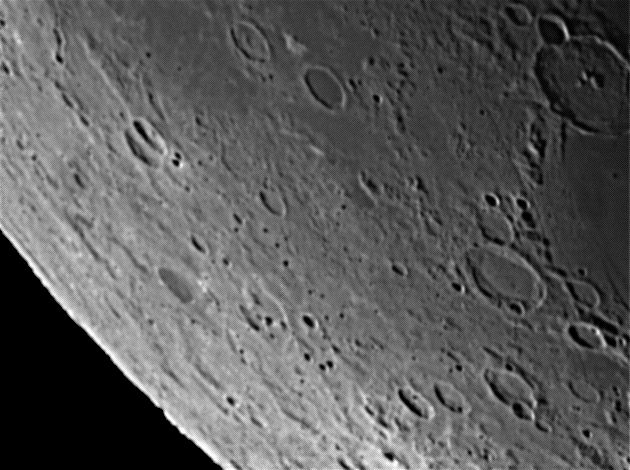
This is another example of the importance of libration in images of the Moon. This picture was taken at the same phase (25 days) as the picture above, but the libration had tipped the Moon over 8° to the west in this picture compared to the earlier one, and the colongitude reflects that fact. Look particularly at Gassendi; in the upper picture it is almost in darkness, whereas in the lower picture it is fully illuminated.
The picture was taken with a ToUcam attached to my LX200 on 17th October 2006, when the Moon was 25.1 days old. The scale markers are approximately 100 Km north and east.
Lunar Phase: 233.8°
Colongitude: 212.0°
Date and Time: 17th October 2006 06:22 UT
Camera: Atik 1-HS
Telescope: LX200 at prime focus
Capture: K3CCDTools. Low gamma, 1/25", 56% gain, 704 frames
Processing: Registax. 637 frames stacked. Wavelets 1-3 = 10, contrast 170, histogram 40-255
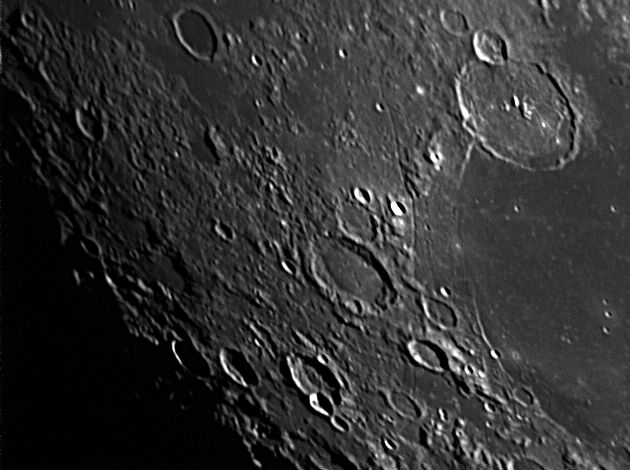
A picture covering Gassendi and the area to the east in similar lighting can be found above.
And now a better picture of this same general area with the light coming from the other direction. The better quality allows us to see some interesting features. Gassendi is a shallow crater because it has been flooded by lava. Although my picture seems to imply that there is a gap in the southern wall through which the lavas could have come from Mare Humorum, this is not so. Higher-resolution pictures show that the wall is continuous so the lavas must have come up through cracks in the floor of the crater. The floor has many rills a few of which may be glimpsed here. Mersenius is outside the depth of the Humorum basin but its floor is domed, evidence of uplifting. Finally the two craters Henry, named after Joseph Henry, an American physicist who invented the electric motor, and Henry Frères named after the brothers Paul and Prosper Henry, French astronomers who pioneered astrophotography, built large refracting telescopes and produced a photographic chart of the skies.
This picture was taken with a DMK21AF04 camera attached to my LX200 on 27th March 2010, when the Moon was 12.3 days old. The scale markers are approximately 100 Km north and east.
Lunar Phase: 28.9°
Colongitude: 61.4°
Date and Time: 27th March 2010 23:34 UT
Camera: DMK21AF04
Telescope: LX200 at prime focus with Astronomik OIII filter
Capture: ICCapture, 1/91" gain 870, 3516 frames
Processing: Registax. 6 alignment points, 413 frames stacked. Wavelets 1-2 = 10
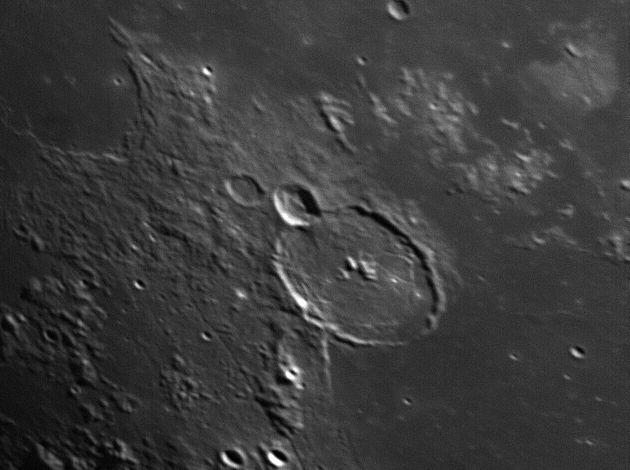
This is one of the first pictures taken using my local Astronomical Society's 14-inch LX200. Both instruments are f/10 so this one has a longer focal length at 3,550 mm and the larger scale is evident. The lighting is a few hours later than the image above. In order to emphasise the uneven floor of Gassendi, I have added an image with the gamma curve shown below.
To see this image, move your mouse pointer over the image and hold down the left mouse button. This feature of the crater is visible also in the image above. I regret the orientation of the image is not the same as above. The Mercenius Rill is shown nicely here as it is in the picture immediately above this one.
The picture was taken with a DMK21AF04 camera attached to a 14-inch LX200 on 28th March 2018 when the Moon was 12.0 days old.
Lunar Phase: 33.9°
Colongitude: 53.5°
Date and Time: 28th March 2018 21:12 UT
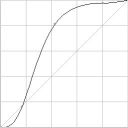 Camera: DMK21AF04
Camera: DMK21AF04
Telescope: 14-inch LX200 at prime focus with Astronomik OIII filter
Capture: ICCapture, 1/183", gain 1023, 3583 frames
Processing: Registax5. 200 frames stacked. Wavelets 1-2 = 10
Home Back to SW Quadrant